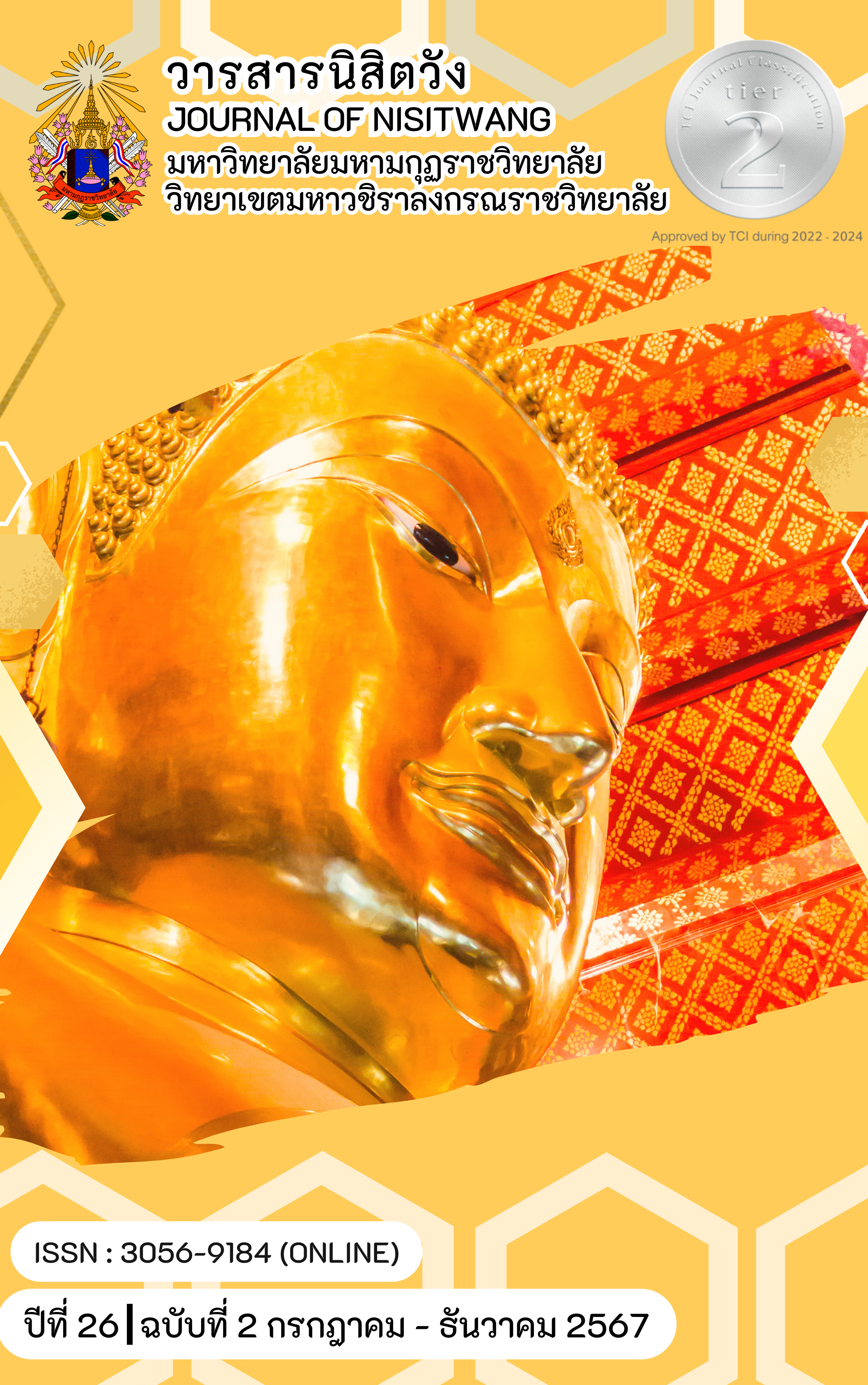การพัฒนาชุดสื่อการเล่นลูสพารตส์เพื่อส่งเสริมความเข้าใจด้านแบบรูป และความสัมพันธ์ของเด็กปฐมวัยโดยใช้กระบวนการคิดเชิงออกแบบ
Main Article Content
บทคัดย่อ
การศึกษานี้มีวัตถุประสงค์เพื่อ 1) พัฒนาชุดสื่อการเล่นลูสพารตส์เพื่อส่งเสริมความเข้าใจด้านแบบรูปและความสัมพันธ์ของเด็กปฐมวัยโดยใช้กระบวนการคิดเชิงออกแบบ 2) ประเมินผลการใช้ชุดสื่อการเล่นลูสพารตส์ กลุ่มเป้าหมาย คือ ครู 10 คนและเด็กปฐมวัยอายุ 5-6 ปี จำนวน 32 คน ที่กำลังศึกษาอยู่ในระดับชั้นอนุบาลปีที่ 3 ภาคเรียนที่ 2 ปีการศึกษา 2566 เครื่องมือที่ใช้ประกอบด้วย 1) แบบสนทนากลุ่มออนไลน์ 2) แบบประเมินคุณภาพชุดสื่อ 3) ชุดสื่อและคู่มือการใช้ 4) แบบประเมินความเข้าใจด้านแบบรูปและความสัมพันธ์ของเด็กปฐมวัย วิเคราะห์ข้อมูลเชิงปริมาณด้วยการหาค่าเฉลี่ย และส่วนเบี่ยงเบนมาตรฐาน วิเคราะห์ข้อมูลเชิงคุณภาพด้วยการวิเคราะห์เนื้อหา
ผลการศึกษาพบว่า
1) การพัฒนาชุดสื่อด้วยกระบวนการคิดเชิงออกแบบ ขั้นที่ 1 การเข้าใจปัญหา พบว่า ครูไม่ทราบเทคนิคการจัดกิจกรรมและต้องการบรรจุภัณฑ์มีความแข็งแรง ขั้นที่ 2 การกำหนดปัญหา ได้ระบุปัญหาเทคนิคการจัดกิจกรรมและบรรจุภัณฑ์ ขั้นที่ 3 การระดมความคิด ได้กำหนดวัสดุที่ใช้ บัตรแบบรูปและความสัมพันธ์ตามลำดับความยากง่าย บรรจุภัณฑ์ คู่มือการใช้ ขั้นที่ 4 การสร้างต้นแบบ ประกอบด้วย ชุดสื่อการเล่นลูสพารตส์และคู่มือการใช้ ขั้นที่ 5 การทดสอบ นำไปใช้กับกลุ่มเป้าหมายและประเมินผล
2) การประเมินผลคุณภาพของชุดสื่อมีคุณภาพดีมาก (µ = 4.78, σ = 0.44) และผลการประเมินความเข้าใจด้านแบบรูปและความสัมพันธ์ของเด็กปฐมวัยอยู่ในระดับดีมาก (µ = 2.86, σ = 0.34) ถือว่าชุดสื่อและคู่มือการใช้ลูสพารตส์มีคุณภาพตามเกณฑ์ที่กำหนด โดยความคิดเห็นของครูปฐมวัย พบว่า ครูมีความรู้ ความเข้าใจเรื่องแบบรูปและความสัมพันธ์เพิ่มมากขึ้น เข้าใจเทคนิคการสอนและนำไปใช้ในการส่งเสริมการเรียนรู้ของเด็กได้ รวมทั้งเด็กเกิดความเข้าใจแบบรูปและความสัมพันธ์ สนุกสนาน และเกิดแรงจูงในการเรียนรู้
Article Details
เอกสารอ้างอิง
กาญจนา ฉิมมา และคณะ. (2562). ผลของการจัดกิจกรรมแบบรูปและความสัมพันธ์ที่เชื่อมโยง วัตถุ ภาพ และภาษา ที่มีต่อทักษะการคิดวิเคราะห์ของเด็กปฐมวัย, วารสารศึกษาศาสตร์ปริทัศน์, 34 (3), 53-60.
เทเรซ่า เคซีย์ และจูเลียต โรเบิร์ตสัน (2564). คู่มือการเล่นลูสพาร์ท : ชิ้นส่วนเคลื่อนย้ายได้ [Loose Parts Play]. พิมพ์ครั้งที่ 1. (เข็มพร วิรุณราพันธ และคณะ, แปล). กรุงเทพฯ. : บริษัท วอล์ค ออน คลาวด์ จำกัด. (ต้นฉบับ พิมพ์ ค.ศ. 2016).
พัทธ์ สุทธิบุญ. (2564). ผลการจัดกิจกรรมการเล่นแบบชี้แนะร่วมกับลูสพารตส์นอกห้องเรียนที่มีต่อพฤติกรรมการเล่นแบบ ร่วมมือรวมพลังของเด็กอนุบาล.วิทยานิพนธ์ครุศาสตรมหาบัณฑิต จุฬาลงกรณ์มหาวิทยาลัย.
ภัทรนันท์ ไวทยะสิน และคณะ. (2565). การพัฒนารูปแบบการจัดการเรียนรู้ด้วยการคิดเชิงออกแบบร่วมกับกระบวนการละครประยุต์เพื่อส่งเสริมความสามารถในการสร้างสรรค์นวัตกรรม. วารสารศรีนครินทรวิโรฒวิจัยและพัฒนา (สาขามนุษยศาสตร์และสังคมศาสตร์) 14 (28), 109-120.
ศศิลักษณ์ ขยันกิจ และธันยา พิทธยาพิทักษ์. (2564). คู่มือ สื่อ เล่น สร้าง เพื่อพัฒนาการคิดของเด็กปฐมวัย. พิมพ์ครั้งที่ 1. กรุงเทพฯ : กู๊ดเฮด พริ้นท์ติ้ง แอนด์ แพคเกจจิ้ง กรุ๊ป.
สถาบันส่งเสริมการสอนวิทยาศาสตร์และเทคโนโลยี (สสวท) กระทรวงศึกษาธิการ. (2560). กรอบการเรียนรู้และแนวทางการจัดประสบการณ์การเรียนรู้บูรณาการวิทยาศาสตร์ เทคโนโลยี และคณิตศาสตร์ในระดับปฐมวัย ตามหลักสูตรการศึกษาปฐมวัย พุทธศักราช 2560. พิมพ์ครั้งที่ 1. กรุงเทพฯ : บริษัท โกโกพริ้นท์ (ไทยแลนด์) จำกัด.
สมฤทัย ศิริบุญชู และคณะ. (2567). ผลการเสริมสร้างความสามารถในการคิดเชิงออกแบบของเด็กวัยอนุบาลโดยใช้การจัดกิจกรรมศิลปะสร้างสรรค์สามมิติร่วมกับแนวคิดลูสพารตส์. วารสารครุศาสตร์ จุฬาลงกรณ์มหาวิทยาลัย, 52 (1), 1-17.
อัชราภรณ์ ฟักปลั่ง และชำนาญ ปาณาวงษ์. (2564). การพัฒนาเกมการศึกษาโดยใช้สื่อจากธรรมชาติเพื่อส่งเสริมทักษะพื้นฐานทางคณิตศาสตร์ สำหรับนักเรียนชั้นอนุบาลปีที่ 2. วารสารวิจัยทางการศึกษา คณะศึกษาศาสตร์มหาวิทยาลัยศรีนครินทรวิโรฒ, 16 (2), 139-150.
Bohling, V., et al. (2010). This never would have happened indoors. [Online]. Available : https://www.communityplaythings.co.uk/learning-library/articles/the-learning-in-loose-parts. [2023, June 25].
Caldwell, J. (2016). Loose Parts. Reggio Inspired. Journal of Education and Human Development, 4 (1), 19-25.
Daly, L., and Beloglovsky, M., (2015). Loose Parts: Inspiring Play in Young Children. [Online]. Available : https://www.redleafpress.org/Loose-Parts-Inspiring-Play-in-Young-Children-P1128.aspx. [2023, June 18].
McDougal, et al. (2023). Assessing the impact of LEGO® construction training on spatial and mathematical skills.[Online]. Available : https://www.researchgate.net/publication/ 372157639_Assessing_the_impact_of_LEGOR_construction_training_on_spatial_and_mathematical_skills. [2023, May19].
McGarvey, L. M. (2012). What Is a Pattern? Criteria Used by Teachers and Young Children. Mathematical Thinking and Learning, 14 (1), 310-337.
Mulligan, et al. (2020). Supporting early mathematical development Through a ‘pattern and structure’intervention program. [Online]. Available : https://link.springer.com/ article/ 10.1007/s11858-020-01147-9. [2023, May 19].
Nicholson, S. (1997). How not to cheat children – The theory of loose parts Landscape. [Online]. Available : https://media.kaboom.org/docs/documents/pdf/ip/Imagination-Playground-Theory-of-Loose-Parts-Simon-Nicholson.pdf. [2023, May 15].
Stanford Design School. (2005). Bootcamp Bootleg from Stanford d. school. [Online]. Available : https://online.stanford.edu/. [2024, November 14].
The Influence of Ministry of Education Republic of Singapore.
(2013). Nurturing Early Learners Minnesota. [Online]. Available : https://www.nel.moe.edu.sg//qql/slot/u143/2022/
Nuturing%20Early%20Learners%20Framework%202022_final.pdf. [2023, May 25].
YALÇIN, V. (2022). Design Thinking Model in Early Childhood Education. International Journal of Psychology and Educational Studies, 9 (1), 196-210.


